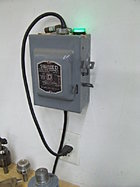I learned something interesting about my lathe the other day.
So I was using my lathe and under a moderate amount of load, it stopped turning. Altogether. The rpm display was showing but the lathe would not turn.
I decided to file a ticket with Laguna.
The next day I thought, oh, duh, maybe I should try unplugging it and replugging it. This seemed to do the trick. Still I had the ticket out and they called me. I explained my situation and the tech said I should look at the code on my VFD. I had and it said, ( I believe ) OC. He asked if I turn my lathe off using the switch or if I unplug it. I said ... uh, I use the switch? He said that when you use the switch the VFD is still connected and drawing power. That if you leave it plugged in for a long time, that it sometimes gets into a messed up state. I told him this seemed like a design problem, and as I write this I am now sure it's a design problem and think it's ridiculous. He was unimpressed with my assessment, and regardless, at least in my case, it is what it is.
While trouble shooting the issue I read some posts. Some people turn the lathe on at the beginning and then use the speed control to start and stop until they are done then they turn it off. I read one post where a fellow did that but then also unplugged the lathe after every session and "it worked great". I thought now come on, this is ridiculous. I didn't build this machine. Professionals did! I should not have to use all these hacks.
Well, turns out he wasn't crazy. Laguna is.
I still love my lathe, and I'm putting in a 220 double pole light switch to deal with the situation but I do think it is pretty messed up.
It also occurred to me, especially since the tech seemed to think this was the most normal thing in the world, that perhaps other lathe brands which use the Delta S1 VFD, of which there are several, may have the same situation. Further it may not be contingent on the VFD, perhaps any lathe that has a VFD that remains on, should be unplugged after use. It's worth considering if you have one.
It always kind of bothered me that the bright digital rpm out put read 0 when not in use. That it didn't just shut down. At the very least it would be worth it to install a PROPER switch on your lathe just to keep the thing from consuming electricity for no reason.
Thanks,
Raif
So I was using my lathe and under a moderate amount of load, it stopped turning. Altogether. The rpm display was showing but the lathe would not turn.
I decided to file a ticket with Laguna.
The next day I thought, oh, duh, maybe I should try unplugging it and replugging it. This seemed to do the trick. Still I had the ticket out and they called me. I explained my situation and the tech said I should look at the code on my VFD. I had and it said, ( I believe ) OC. He asked if I turn my lathe off using the switch or if I unplug it. I said ... uh, I use the switch? He said that when you use the switch the VFD is still connected and drawing power. That if you leave it plugged in for a long time, that it sometimes gets into a messed up state. I told him this seemed like a design problem, and as I write this I am now sure it's a design problem and think it's ridiculous. He was unimpressed with my assessment, and regardless, at least in my case, it is what it is.
While trouble shooting the issue I read some posts. Some people turn the lathe on at the beginning and then use the speed control to start and stop until they are done then they turn it off. I read one post where a fellow did that but then also unplugged the lathe after every session and "it worked great". I thought now come on, this is ridiculous. I didn't build this machine. Professionals did! I should not have to use all these hacks.
Well, turns out he wasn't crazy. Laguna is.
I still love my lathe, and I'm putting in a 220 double pole light switch to deal with the situation but I do think it is pretty messed up.
It also occurred to me, especially since the tech seemed to think this was the most normal thing in the world, that perhaps other lathe brands which use the Delta S1 VFD, of which there are several, may have the same situation. Further it may not be contingent on the VFD, perhaps any lathe that has a VFD that remains on, should be unplugged after use. It's worth considering if you have one.
It always kind of bothered me that the bright digital rpm out put read 0 when not in use. That it didn't just shut down. At the very least it would be worth it to install a PROPER switch on your lathe just to keep the thing from consuming electricity for no reason.
Thanks,
Raif

